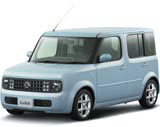Centre of attention
As Nissan opens the doors to the Rotunda, its design studio in London’s Paddington, Nargess Shahmanesh talks to the head of design Shiro Nakamura

Nissan’s European design centre in London’s Paddington – the Rotunda – which opens today, is unlike many others. It will not be a forum for designing just show cars, insists Shiro Nakamura, senior vice-president and director of design at Nissan, and the man in charge of the studio. Instead this will be Nissan Europe’s main design centre.
‘This is a real design centre, not just a satellite studio,’ says Nakamura. Nissan wanted to integrate all its European design studios, and have a centre that contributes to its design philosophy in Japan and the US. In a way, the studio represents Nissan’s new identity.
In 1999, Renault took over Nissan and Nakamura was headhunted to lead Nissan design. The Japanese carmaker was doing badly for years, and its new chief executive, Carlos Ghosn, made it his mission to restructure the company. ‘He wanted to revive Nissan by creating a new management structure and a more global perspective,’ explains Nakamura. Ghosn had a clear vision as to how design could help his mission.
This was a good opportunity for Nakamura. Japan, he says, can be closed in terms of design. He had worked most of his life at Isuzu, then one of Japan’s top three carmakers. ‘In Japanese design history, the head of design is never brought in from outside, and never leaves.’ Nakamura wanted to break this mould.
He first studied industrial design in Japan, then transport design at Pasadena in California, as well as spending a year at General Motor design in the US. He also worked in Europe, including the UK, where he feels he learnt a great deal in terms of design structure. ‘If you work in Europe and the US, you work on a more global and open scale. In Japan there is little freedom. Design isn’t just about design; it is also about design management. In Japan you have no freedom with budget, human resources, or anything,’ he adds.
At Nissan, Nakamura reports to executive vice-president Patrick Pélata, who reports to Ghosn, but, he says, the system is not that rigid. Globally, Nissan used to have different independent strategies. Nakamura integrated all design studies and created one design policy. ‘We need to know how to utilise global resources. I usually travel once or twice a month to our separate sections, and sit down face to face with my designers.’
Nissan design is totally independent from Renault, insists Nakamura. The sharing of information is in fact there to try to keep the two apart. ‘The work Renault design does is right for Renault, and the same applies to Nissan.’
The Nissan Datson 240Z was hot stuff in the 1970s, and the old Z sport coupés are almost the only Japanese cars to have become modern classics in Europe and the US. The new Nissan 350Z is the symbol of Nissan’s revival, says Nakamura. ‘We may not be making retro cars, but we are keeping the heritage of the Z cars.’ Nissan had all design teams contribute to the design of the 350Z, and to him it is symbolic of a global Nissan.
Japan does not have a strong history of vehicle design, he says. ‘Historically we are followers of design. In the past a car would come from Europe, and we would reinvent it. We now have to create our own Japanese language. Japan has a lot of design heritage in terms of product and architecture, but it has another side to its culture. One side of the culture is pure, the other mixed with cultures coming from countries like China.’
Nakamura points to the Nissan Cube, sold exclusively in Japan, as reflecting the future of Nissan design. ‘This car shows our culture,’ he says. The Cube – intended for a limited audience – will be displayed at Paddington. ‘We want to see what reaction it gets in Europe.’
Some critics say that now more than ever design is crucial to the survival of car manufacturers. Nakamura thinks design has always been the most important factor in attracting people, but now the consumer is expecting more expressive design. The future used to be lucid, he says. In the 1970s you had square cars, round ones in the 1980s. ‘Future trends aren’t so clear. The future will be a co-existence of different design directions.’
For the new centre, London offered the best solution. Both Nissan engineering and manufacturing are based in the UK, and Nakamura thinks London is special. ‘It is a very attractive place for new designers,’ he says. Counting designers, modellers and support staff, employees will number around 50, and they’ll be an international bunch for sure.
Shiro Nakamura’s CV
March 1974: Graduated from Musashino Art University, Tokyo – Bachelor of Art in Industrial Design
October 1981: Graduated from Art Centre College of Design, Pasadena, California – Bachelor of Science in Transportation Design
April 1974: Joined Isuzu Motors, Japan
February 1986: Chief designer, in charge of Gemini among others
January 1989: Isuzu Motors Europe, Brussels/ Birmingham, UK – Design manager/ chief designer
April 1997: American Isuzu Motors, California – Vice-president, product planning
April 1998: Isuzu Motors, Japan – General manager, design centre
October 1999: Joined Nissan Motor Corporation – Assistant to EVP in charge of design division
January 2000: Design director
July 2000: Vice-president, design director
April 2001: Senior vicepresident, design
-
Post a comment



